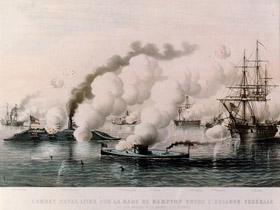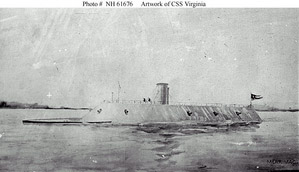


| |||||||||||||||||||||
|
The Battle of Hampton Roads, often called the "Battle of the USS Monitor and the CSS Merrimac", was a naval battle, famous for being the first fight between 2 powered iron-covered warships, or "ironclads", the CSS Virginia and the USS Monitor. It took place off Sewell's Point, a narrow place near the mouth of Hampton Roads. Although the battle was inconclusive, it is significant in naval history. Prior to then, nearly all warships were made primarily of wood.
Occupation of Norfolk gave the Confederacy its only major shipyard and thousands of heavy guns. Brig. Gen. Walter Gwynn, who commanded the Confederate defenses around Norfolk, erected batteries at Sewell's Point, both to protect Norfolk and to control Hampton Roads.
The Virginia, commanded by Capt. Franklin Buchanan, was supported by the CSS Raleigh and CSS Beaufort, and accompanied by the CSS Patrick Henry, CSS Jamestown, and CSS Teaser.
On March 8, from her berth at Norfolk, the ironclad Virginia steamed into Hampton Roads where she sank the USS Cumberland and ran the USS Congress aground. Her appearance was a tactical surprise: there had been plenty of rumors that something was happening to the old USS Merrimac, but over time the rumors became too common and were ignored.
After her initial victory, the Virginia returned to Norfolk to reload ammunition and rest; the next day she would return and destroy any more Union ships foolish enough to test her. But overnight, in one of the luckiest strokes of timing in the war the ironclad Monitor arrived to do battle. Her task was unglamorous in that it was negative: she only needed to stop the Virginia. Destruction or damage was incidental, and Monitor’s first task was to keep herself afloat and dangerous. Virginia tried to knock the Monitor out, but overnight, having expected to fight more wooden ships, had loaded mainly shells rather than shot.
The next morning, on March 9, after undergoing repairs, Virginia returned to finish off the grounded USS Minnesota. The way was blocked by the newly arrived Monitor, which the commander of the Confederate ship later described as "little more than a cheesebox on a raft".



Drawing of the CSS Virginia |



Drawing of the USS Merrimac |
After fighting for hours, mostly at close range, neither could overcome the other. The smaller and nimbler Monitor was able to outmaneuver the Virginia, but neither ship proved able to do significant damage to the other.
It had been a frightening and demoralizing day for the Union Navy. Late that night, USS Monitor, commanded by Lt. John L. Worden, arrived in Hampton Roads. The Union ironclad had been rushed to Hampton Roads in hopes of protecting the Union fleet and preventing Virginia from threatening Union cities.
The first ironclad duel in history was a draw. The Monitor took considerable damage, sufficient that she pulled into water shallower than Virginia could enter, but Virginia had also taken too much damage and she retired. She would never fight again; the Confederacy had strained its industrial base to build an ironclad and didn’t have the resources to continue building the various ships scattered around her perimeter and quickly repair Virginia. By the time she was patched, Union troops were at the gates of Norfolk. Virginia wasn’t adequately seaworthy to go up the Chesapeake, let alone the high seas, and she drew too much water to go up the James. She had to be destroyed.
While the tactical battle was inconclusive, the strategic balance remained in the Union's favor.



|
